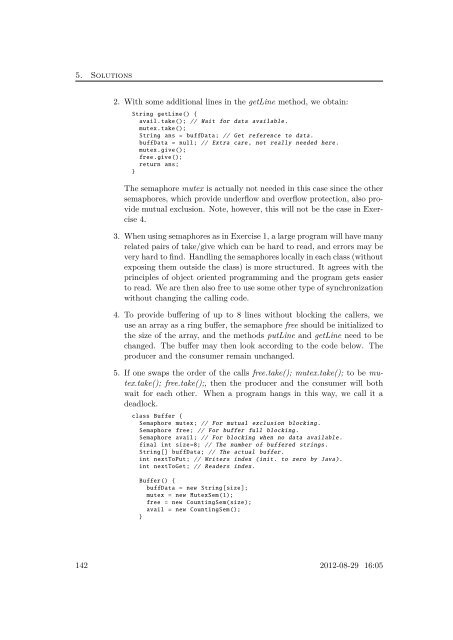JAVA-BASED REAL-TIME PROGRAMMING
JAVA-BASED REAL-TIME PROGRAMMING
JAVA-BASED REAL-TIME PROGRAMMING
You also want an ePaper? Increase the reach of your titles
YUMPU automatically turns print PDFs into web optimized ePapers that Google loves.
5. Solutions<br />
2. With some additional lines in the getLine method, we obtain:<br />
String getLine() {<br />
avail.take(); // Wait for data available.<br />
mutex.take();<br />
String ans = buffData; // Get reference to data.<br />
buffData = null; // Extra care , not really needed here.<br />
mutex.give();<br />
free.give();<br />
return ans;<br />
}<br />
The semaphore mutex is actually not needed in this case since the other<br />
semaphores, which provide underflow and overflow protection, also provide<br />
mutual exclusion. Note, however, this will not be the case in Exercise<br />
4.<br />
3. When using semaphores as in Exercise 1, a large program will have many<br />
related pairs of take/give which can be hard to read, and errors may be<br />
very hard to find. Handling the semaphores locally in each class (without<br />
exposing them outside the class) is more structured. It agrees with the<br />
principles of object oriented programming and the program gets easier<br />
to read. We are then also free to use some other type of synchronization<br />
without changing the calling code.<br />
4. To provide buffering of up to 8 lines without blocking the callers, we<br />
use an array as a ring buffer, the semaphore free should be initialized to<br />
the size of the array, and the methods putLine and getLine need to be<br />
changed. The buffer may then look according to the code below. The<br />
producer and the consumer remain unchanged.<br />
5. If one swaps the order of the calls free.take(); mutex.take(); to be mutex.take();<br />
free.take();, then the producer and the consumer will both<br />
wait for each other. When a program hangs in this way, we call it a<br />
deadlock.<br />
class Buffer {<br />
Semaphore mutex; // For mutual exclusion blocking.<br />
Semaphore free; // For buffer full blocking.<br />
Semaphore avail; // For blocking when no data available.<br />
final int size=8; // The number of buffered strings.<br />
String[] buffData; // The actual buffer.<br />
int nextToPut; // Writers index (init. to zero by Java).<br />
int nextToGet; // Readers index.<br />
Buffer() {<br />
buffData = new String[size];<br />
mutex = new MutexSem (1);<br />
free = new CountingSem(size);<br />
avail = new CountingSem ();<br />
}<br />
142 2012-08-29 16:05

















